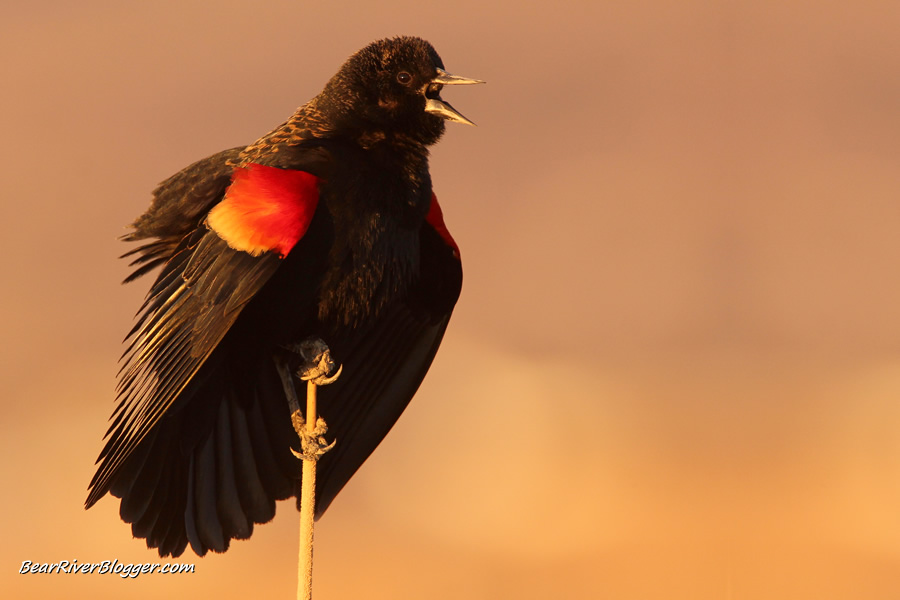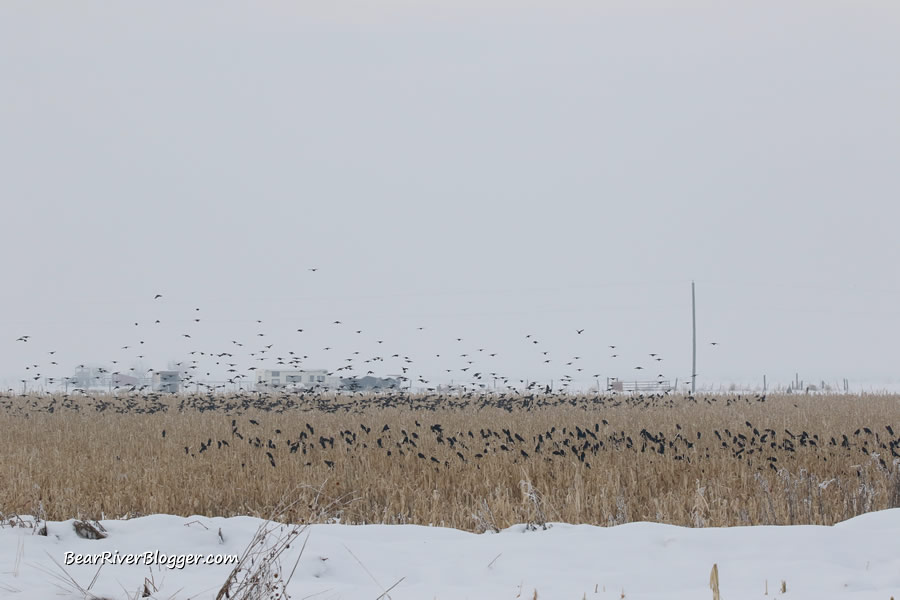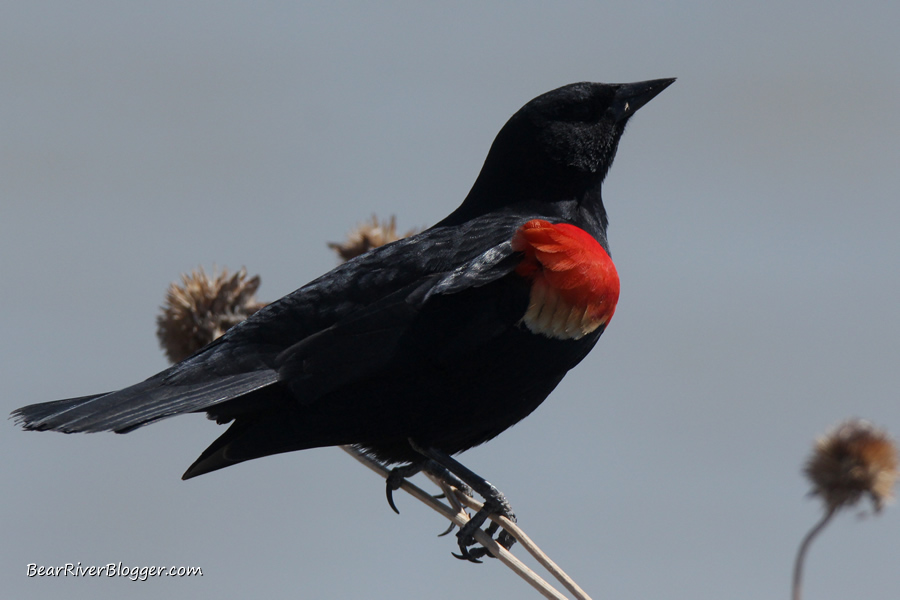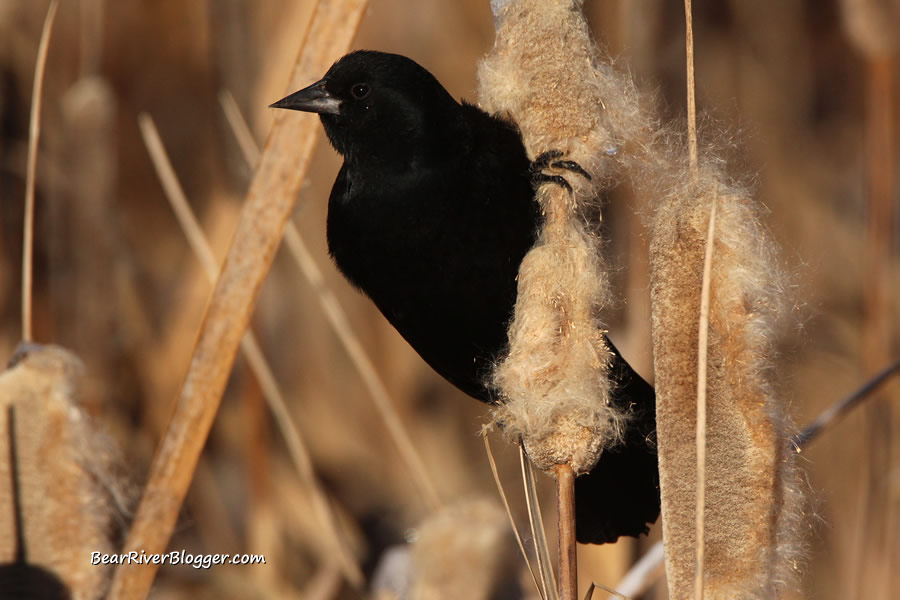It’s been a while since I’ve photographed or even mentioned the red-winged blackbird so today’s blog post is dedicated to them, one of my favorite subjects ever to sit and pose in front of my camera.
Oh, how I love the sweet song of the male red-winged blackbird during spring, it is truly one of the sweetest sounds and most interesting displays in the bird world.
But being as we are now just heading into what seems to be shaping up as a cold and very wet winter, there won’t be any mention of photographing singing blackbirds on cattails in this particular blog post sorry to say.

That is more of a springtime ritual I’ll try and address down the road sometime when love is in the air and their hormones are on the rise, making it quite easy to photograph the male red-winged blackbird during their eye-catching courting and mating ritual and display.
Today’s written offering, however, will talk a little bit about what red-winged blackbirds do during the dreads of winter, particularly what they eat and where they go.
Simply put, red-winged blackbirds live in wetlands, including both fresh and saltwater marshes, all over the United States and much of Canada.
And being as wetlands are very productive ecosystems, most of the red-winged blackbird’s summer diet is a variety of bugs and insects that thrive in these environments.
(Singing Red-winged Blackbird.
Don’t forget to subscribe to our Bear River Blogger YouTube channel for short nature clips, occasional live feeds, and periodic updates about the Bear River Migratory Bird Refuge and other places in nature of interest.)
Many red-winged blackbirds across the United States, however, do not migrate, or if they do they only migrate short distances.
With that said, the red-winged blackbirds does, however, move around a lot locally during winter to find food as their previous summer bounty of bugs and insects are now gone for the season.
And during these winter wanderings, red-winged blackbirds will search for and eat seeds from cocklebur and other weeds, sunflower seeds, waste grains from both agricultural fields and feedlots, and, of course, being a wetland bird, cattail seeds.

I have personally watched red-winged blackbirds eat all of these during winter but it seems to me until the snow gets deep enough to bury harvested corn and wheat fields, thus making them quite inaccessible, waste grains are by far the most common and most preferred food source of the red-winged blackbird during winter if they happen to live in an agricultural area that is.
Here on the Bear River Migratory Bird Refuge auto tour route during spring and summer, red-winged blackbirds are everywhere it seems, a most common and very easy bird to find that time of year.
But as winter takes hold, red-winged blackbirds become a bit more and more scarce on the bird refuge as many of them do indeed head to nearby agricultural fields to find waste grains and roadside weeds.
At times, I have seen flocks with as many as several hundred or more red-winged blackbirds feeding in spent grain fields during November and December.

And being a bird watcher myself, it is quite a sight to see as these large flocks of blackbirds fly from one field to another in a somewhat sense of precision of sorts, all somehow deciding together what field to feed in next.
Some blackbirds are still found on the refuge wetlands, mind you, but typically only in small to moderately sized flocks in certain places along the auto route that offer cocklebur, cattail, and other natural growing seeds to feed upon during the cold, wintery months.
This past week, in fact, I was able to watch and photograph a solitary red-winged blackbird perched in a small roadside patch of cattails, hopping from one plant to another anxiously feeding on the small seeds.
It was a stark reminder of how important natural vegetation is for local bird populations to help them get through our sometimes very harsh winters and how vital protected wetlands such as the Bear River Migratory Bird Refuge are to winter bird populations.

This is why the threat of the ever-encroaching and invasive phragmites plant is a real one in wetland habitats all across the United States and right here in Utah, it literally chokes out and kills the native vegetation such as cattails that some birds depend on not only for nesting material but for food during the winter months.
And as agricultural areas are slowly being eaten up by housing and other urban development threats, native vegetation in wetland areas like the cattail becomes more and more important if we want birds such as the red-winged blackbird around for years to come.
I hope this blog post has not only entertained but helped enlightened a little bit about the red-winged blackbird during the winter months.
If you are a bird watcher like I am, I offer you to head on over to our subscribe page and sign up for email notifications for future blog posts like this one.
I’d Rather Be Bird-Watching Apparel
Show off your love for bird watching as well as support our website and YouTube channel with this unique line of “I’d Rather Be Bird Watching” line of t-shirts and hooded sweatshirts, currently available in both t-shirts and hooded sweatshirts in a variety of sizes and colors.








